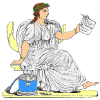|
Örjan Martinsson
| |
|


National militia soldiers (conscripts) depicted in 1704-1706
on a relief in Rosenborg castle (a close up is available
at the bottom of this page).
During the first decade of the
18th century, the Danish army mainly wore light grey coats with each
regiment having their own distinctive colour on the cuffs and lining and
facings. A new uniform regulation on 24 October 1711 stipulated that the
Danish army would henceforth have red coats. The regiments serving as
auxiliary troops for the Maritime powers were not covered by this, however,
and it was only with the regulation from 1716 that the entire Danish army
had its red uniforms established.
At the beginning of this
period, the vest and leg clothes (breeches and stockings) were usually
the same colour as the cuffs and lining. But according to Daniel Schorr and
Lars-Eric Höglund, these garments in all regiments would be red from 1711
onwards. Karsten Skjold Petersen claims, however, that this only applied
from 1716 onwards and that vests and leg clothes before that were in the
regimental colour. However, it is reported that soldiers had gaiters made of
red tent cloth that covered the stockings at the battle of Gadebusch 1712.
Some details are difficult to
find information about. For example, there is little information about the
colour of the hat lace. These may have been in the regimental colour (earlier
part of the period?) or in the button colour (later part of the period?).
Thus, if they had "yellow" brass buttons, it is likely that the hats were
edged with yellow lace, and if they had "white" silver or pewter buttons,
they may have had white lace. The hat also had a cockade which at the
beginning of the period may have been in the regimental colour and later
became black.
The colour of the collar is
usually not reported separately (Karsten Skjold Petersen lumps them together
with the cuffs) and therefore it is not easy to determine if the regiments
had collars on their coats. I have assumed that the uniforms in the first
decade of the 18th century generally lacked collars but that they came into
use at the time of Denmark's re-entry into the war in 1709. According to
Karsten Skjold Petersen, a collar was included in the m/1711 uniform and
would remain until it temporarily disappeared from the uniforms in 1731
From
1728, there are drawings by Worgewitz showing that the enlisted regiments
(but not the national militia) wore their coats unbuttoned and with the skirt
folded up. Exactly when this change took place is unclear, but according to
Karsten Skjold Petersen, the m/1711 uniforms did not have turnbacks.
I have depicted the m/1716 uniforms below in accordance with Worgewitz's
drawings, but the change may have taken place later.

The funeral procession of
Christian V's half brother Christian Gyldenløve in 1703.
Engraving by Andreas Reinhard c.
1707.
In the middle, grenadiers from the Grenadiers Corps can be seen (a
close up is available at the bottom of this page)
|
|
Livgarden til
Fods
(Foot Guards) |
|

1686-1702 |

1707-1713 |

1714-1716 |

1716-1731 |
|
Paille yellow coat with red lining and cuffs and 72 white
buttons. Red cassock/cloak with paille yellow lining and cuffs and
yellow buttons. Red vest and red leg clothes. |
Paille yellow coat with red lining and cuffs and 34 brass
buttons. Red coat with paille yellow lining and cuffs and yellow buttons.
Red vest and red leg clothes. Hat with gold lace and black cockade. Red
cover with embroidery and lace on the cartridge box. |
Red coat with paille yellow lining and paille yellow
cuffs with a silver stripe and 34 silver-plated buttons and white
buttonholes. Paille yellow vest and paille yellow leg clothes. Hat with
silver lace and black cockade. Paille yellow cover with silver
embroidery on the cartridge box. White neckcloth. |
Same as before but with red leg clothes. |
During the Scanian campaign of 1709-1710, a Swedish spy report stated
that the Foot Guards had "red coats and cloaks with yellow cuffs and
collars". The uniform issued in 1707 clearly had the reverse colours,
but the Foot Guards seem to have brought an older uniform with them
during the campaign in order to reduce wear and tear on the regular
uniform. Whether it consisted of the red cassocks with yellow lining
that were abolished in 1702 or whether the Foot Guards had red coats in
1702-1707 is unclear. Non-commissioned officers and musicians did have
red coats in 1702-1707, but the officers had ponceau red coats with paille yellow facings from 1708 which were the reverse colours compared
to the privates.
|
|
Grenaderkorpset
(Grenadier Corps)
|
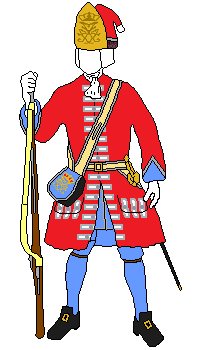
1702-1706 |

1708-1709 |

1712-1716 |

1724-1731 |
|
Red coat with pewter buttons and light blue lining
and light blue cuffs with silver lace. The coat was decorated with
20 ell of white silk lace and 8 “lod” silver lace. Cloak with
embroidered coat of arms (on the left shoulder?). Bearskin cap with
brass plate. 30 pewter buttons for both coat and cloak (according to
an engraving, the coat was single-breasted
with 16 buttons). Light blue breeches and white neckcloth. Frederik
IV's monogram in brass on the cartridge box. Tinned fuse cover on
the bandoleer. |
Since 1706, red coat with blue cuffs and collar and
26 silver-plated buttons. Blue stockings. Bearskin cap with a front
of blue and some red cloth and gilded name cipher, red bag, and
edged with silver lace. Brass fuse cover. In 1708, the corps
received permission to have waist belt, bandoleer and cover of the
cartridge box, covered with blue cloth and edged with silver lace. |
Red coat with 34 white buttons (3 on each cuff) and
white buttonholes as well as light blue lining and cuffs. Light blue
vest and leg clothes.
1716-1724
Same as above but with red leg clothes. |
Red coat with white buttons and buttonholes and light
blue lining and cuffs. Light blue vest and red leg clothes. In 1724,
a new type of grenadier cap made of leather was introduced and at
the same time the bandoleer, waist belt and the cover of the
cartridge box ceased to be covered with blue cloth. |
|
The
appearance of the uniform worn in 1709-1712 is unknown. |
|
Dronningens Livregiment
(Queen's Life Regiment) |
|

1691-1702, dec. 1709 |

?-1711 |

1712-1716 |

1716-1731 |
|
Red coat with yellow lining and cuffs. Brass buttons
1705. |
Yellow coat, yellow lining and cuffs |
Red coat, yellow lining and cuffs, pewter buttons (yellow
leg clothes?). |
Same as before but with a red vest and red leg clothes. |
In 1702, in addition to
scarlet coats, the officers also had white stockings, white feathers in
their hats and a white sash around their waists. The grenadier caps at
the same time were of yellow plush, but with a black velvet front with
silver embroidery and in the centre of this the regimental name was
embroidered ("Königin" or "Droningen"). In addition to the
coat, the regiment's soldiers also had a red cassock with cuffs and
collar made of yellow plush.
Mitre-type grenadier caps are
also mentioned in a contemporary description from 1705 of the battalion sent
to Austria. The cap was described at a troop parade as being of red plush
with a yellow shield and on the back "The Queen" embroidered in silver. The
spelling should be Danish "Droningen" because the Holy Roman Empress
asked the Danish ambassador what the word meant. It is on this occasion that
the regiment is said to have had brass buttons.
The regiment was described at Gadebusch in 1712 as wearing both red, blue and gray uniforms. There were
then coats that were made with 40 different coloured patches. The condition
of the uniforms was so bad that the regiment had to take uniforms from one
battalion and leave it in quarters, in order to equip the other so that it
could take part in the battle. |
|
Prince Christian's
Regiment |
|
 
1691-1710 |

1714-1716 |

1716-1721 |
|
Light grey coat with red cuffs (the shades are described as
"grey" 1691, "light grey" 1695, "iron grey"
1702, "white" 1709 and "crimson" 1691, "dark red" 1695
and "red 1702 & 1710). Cloaks/cassocks in the same colour as the coat
1702 and 1709. Red stockings 1702 |
Red coat with brass buttons and black lining, collar and
cuffs (black leg clothes?). |
Red coat with pewter buttons and light blue buttonholes
and lining, light blue cuffs and collar with black stripe, red vest and
leg clothes.
|
The officers are mentioned in 1702 to have had the same
colour as the privates except for the lining and sash. At the same time,
the grenadiers had caps made entirely of fur. In Austria, however, they
are mentioned as having had cloth grenadier caps with the regimental
name embroidered on the back. There are also different descriptions of
what the m/1716 uniform's cuffs looked like.
|
Prince
Georg's Regiment
(disbanded 1721) |
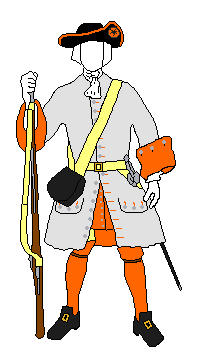
1695- |

1704 |
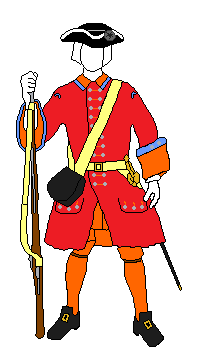
1713-1716 |

1716-1721 |
|
Light grey
coat with orange/dark yellow cuffs and lining. |
Blue coat with
orange/dark yellow cuffs and lining. In English service 1701-1713. |
Red coat with
aurora coloured lining and cuffs, and blue stripes on cuffs and sleeves. |
Red coat
with aurora coloured lining and cuffs, and blue stripes on cuffs
and sleeves. Red vest and leg clothes. Pewter buttons since 1717. |
There are different descriptions of what
the m/1716 uniform's cuffs looked like. |
|
Prince Carl's
Regiment |
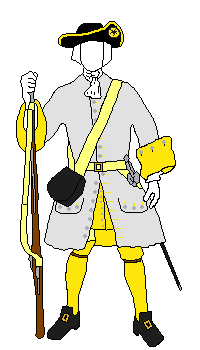
1691-1695 |

1704 |
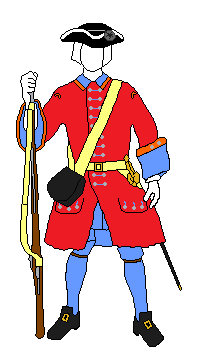
1714-1716 ? |

1716-1722 |
|
Light grey
coat with orange/dark yellow cuffs and lining. |
Blue coat with
orange/dark yellow cuffs and lining. In English service 1701-1713. |
Red coat with
aurora coloured lining and cuffs, and blue stripes on cuffs and sleeves. |
Red coat
with aurora coloured lining and cuffs, and blue stripes on cuffs
and sleeves. Red vest and leg clothes. Pewter buttons since 1717. |
Snorrason cites a source (Vrigny) that wrote that
the newly formed dragoon regiment Württemberg-Oels had grey coats with
yellow facings in 1702, but believes that it actually describes Prince
Carl's regiment, which was in the same location, because the dragoon
regiment's enlistment patent states blue coats with red facings. Skjold
Peterson, on the other hand, has assumed that the source has given the
correct regimental name. The consequence of this seems be that two
uniforms and two regiments have been combined in different ways by
Snorrason and Skjold Petersen.
There are different descriptions of what
the m/1716 uniform's cuffs looked like. |
Sjællandske
Regiment
(Zealand Regiment) |

1691-1695, (1708?) |
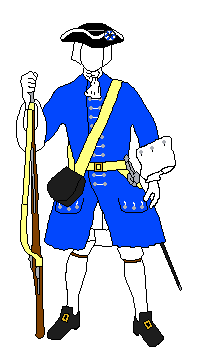
1704 |

1714-1716 |
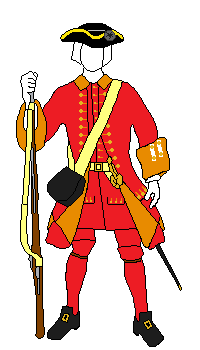
1716-1723 |
|
Light grey
coat with blue cuffs and lining. |
Blue coat with
white cuffs and lining. In Dutch service 1701-1714. |
Red coat with
cuffs, lining (and leg clothes?) in feuille morte and brass buttons. |
Same as
before but with red vest and red leg clothes. |
Snorrason mentions a decision from 1707 that Sjællandske should have brass buttons and blue wool for the buttonholes
as well as blue breeches and stockings. These colours are also stated by
Skjold Petersen for the year 1708, which indicates that the uniform
regulation of 1691 was also followed in the 18th century, even though
Skjold Petersen does not mention anything about grey coats. |
Jyske
Regiment
(Jutland Regiment) |
 
1685-1710 |

1714-1716 |
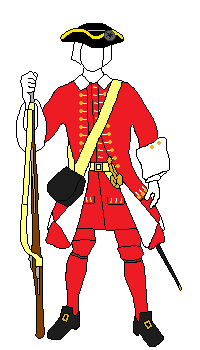
1716-1731 |
|
Light grey
coat with red lining cuffs. Colours of hat and neckcloth according to a
description by Vrigny from 1702. |
Red coat with
white cuffs, buttonholes and lining and brass buttons. |
Same as
before but with red vest and red leg clothes. |
|
Fynske
Regiment
(Funen Regiment) |
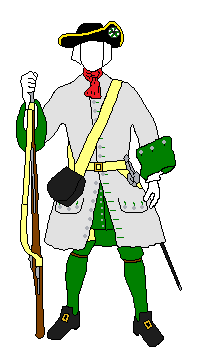 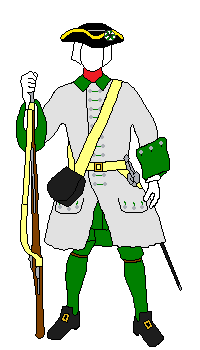
1691-1710 |

1714-1716 |

1716-1731 |
|
Light grey
coat with green cuffs and lining. In 1702, the vest and leg clothes were
described to be green (grey white vest for officers), the buttons white, the hat brim yellow and the
cockade green-white. The collar was stated in 1702 to have been red, but
the source might have misidentified a neckcloth as a collar. |
Red coat with
green cuffs, lining, and leg clothes, and since 1712 brass buttons. |
Same as
before but with red vest and red leg clothes. |
What shade Fynske Regiment's green colour had was not mentioned
until 1735 when it was stated to be dark green.
A plate from 1716
showing the different regiments' cuffs, however, has depicted Fynske in a light green shade.
|
|
Oldenborgske
Regiment |

1691-1699 |

1701-1713 |

1713-1716 |

1716-1731 |
|
Light grey
coat with cuffs and lining in “muscus” (= reddish brown or dark brown). |
The uniform
unknown during the War of the Spanish Succession when Oldenburg was in
English service. |
Red coat with
brass buttons and light green cuffs with a white stripe. |
Red coat
with brass buttons, light green lining, light green cuffs with
aurora stripe. Red vest and leg clothes. |
|
Marineregiment
(Marine Regiment) |
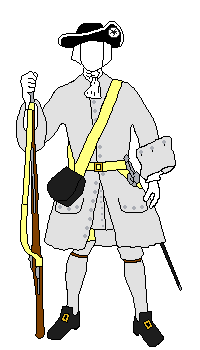
1695- |
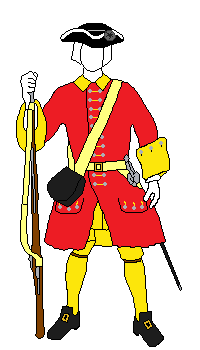
December 1709 |
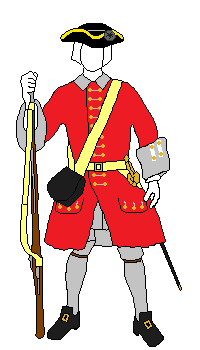
1714-1716 |

1716-1721 |
|
Light grey
coat with light grey cuffs and lining. |
Red coat with
lemon yellow cuffs and collar according to a Swedish spy report. However,
should also have had a grey coat with orange cuffs in the same year. |
Red coat with
steel grey lining, steel grey cuffs with white lace and brass buttons. |
Red coat
with aurora lining and aurora cuffs with white lace. Brass buttons,
red vest and leg clothes. |
|
"Copenhagen
Garrison Regiment"
(was named after its colonels: Schack, Schwärtzel, Prince of Hesse and
Zepelin) |
 
m/1691 |
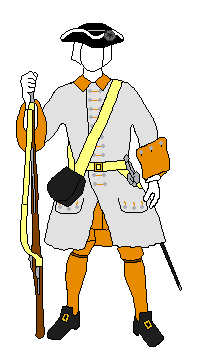
December 1709 |

1713-1714 |
|
Light grey
coat with lining in feuille morte. The cassock (overcoat) in the picture
on the left was abolished in 1707 in the Danish army. |
A Swedish spy
report states that they had white coats and cloaks with brownish yellow
cuffs and collars |
Red coat
with cuffs and lining in feuille morte and white lace on the
cuffs. Brass buttons |
This regiment was merged in 1714 with the Sjællandske Regiment which had returned home from Dutch service. Karsten
Skjold Petersen does not mention this regiment in his book, but I
suspect that his uniform information from 1712-1713 about the Sjællandske Regiment refers to this regiment. According to him, Sjællandske received new uniforms in 1713 and that should therefore have
been the date for when the "Copenhagen Garrison Regiment" received its
m/1711 uniform. |
First
Danish Regiment
(was named after its colonels Lepel, Birkholtz and Staffeldt among
others) |
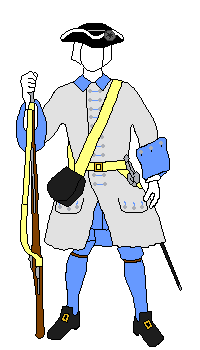
1709- |
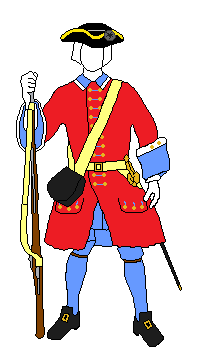
-1716 |
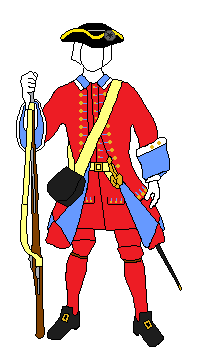
1716-1721 |
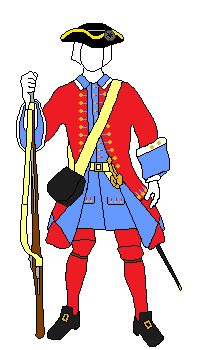
1728-1731 |
|
Light grey
coat with blue lining, collar and cuffs (according to Vaupell it was a
light blue shade) |
Red coat with
yellow buttons, light blue lining and light blue cuffs with white
stripes. |
Same as
before, but with red leg clothes and red vest |
Same as
before, but with a light blue vest which was introduced at the
latest in 1728.. |
|
Second
Danish Regiment
(disbanded 1721, was named after its colonels such as H. J. Arnold) |

1709- |
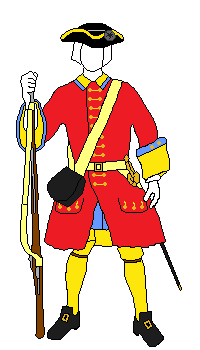
-1716 |
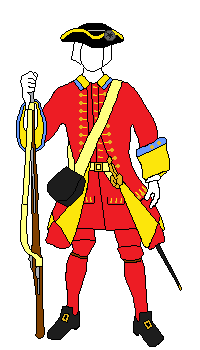
1716-1721 |
The cuffs in the pictures on the right
follow the plate from 1716. However, Daniel Schorr and Lars-Eric
Höglund have the colours in reverse order, while Karsten Skjold
Pedersen is more vague and does not indicate the order of the
colours. However, given that the lining was yellow, it seems that
yellow was the main colour.
The plate and Schorr's information are reported in more detail on
a separate page. |
|
In 1709, had a
light grey coat with blue lining and blue cuffs. Unlike First Danish,
the collar is not mentioned. |
Red coat with
yellow buttons, yellow lining and blue and yellow cuffs (vest made from
the 1709 coat?). |
Same as before
but with red vest and leg clothes. |
|
Third
Danish Regiment
(was named after its colonel M. Kragh after its return from Austrian
service in 1709) |
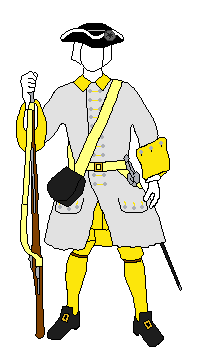
1709- |
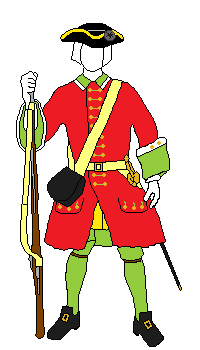
1713-1716 |

1716-1735 |

1735-1750 |
|
Light grey
coat with yellow cuffs and lining. Unlike First Danish, the collar is
not mentioned. |
Red coat
with brass buttons, green lining and green and white cuffs (vest made
from the 1709 coat?). |
Same
as before but with red vest and red leg clothes.
From 1731, the coat would not have a collar. |
Red coat with dark green lining, cuffs and buttonholes as well as white
buttons. Dark green vest and red leg clothes. |
|
Fourth
Danish Regiment
(disbanded 1721, was named after its colonels such as Friis and
Callenberg) |
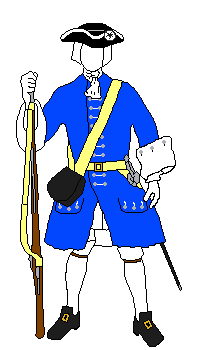
1703? |
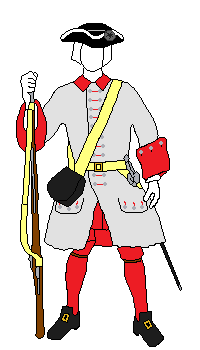
1709- |

-1716 |

1716-1721 |
|
According to
the enlistment patent of 1701, the regiment was to have blue coats with
white facings. |
Light grey
coat with red cuffs and lining. Unlike First Danish, the collar is not
mentioned. |
Red coat with
brass buttons and yellow lining and black and yellow cuffs (vest made
from the 1709 coat?). |
Same as
before but with red vest and red leg clothes. |
The cuffs in the pictures on the right follow the
plate from 1716. However, Daniel Schorr and Lars-Eric Höglund have the
colours in reverse order, while Karsten Skjold Petersen is more vague
and does not indicate the order of the colours. However, given that the
lining was yellow, it seems that yellow was the main colour. |
|
Other Enlisted Units |
|
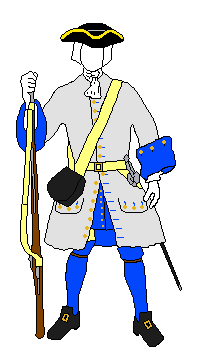
Maltzahn's Battalion
1701-1703 |

Württemberg-Oels
1701-1714 |

Callenberg's
Battalion
1711-1713 |

Klepping's
Battalion
1712-1713 |
|
Light grey coat with blue lining and cuffs, cloak the
same, as well as leather breeches and blue stockings. In 1702 they
received blue vests which, like the coat, had brass buttons. The
buttons on the coat were covered with "material" |
According to the enlistment patent of 1701 it would
have a light grey coat and cassock with blue lining and cuffs.
Höglund is the only one to mention a red coat with a blue collar,
cuffs and lining for 1712. |
Unknown uniform. |
Light grey coat with red lining and cuffs. Red
breeches and stockings. |
|

Hansen's Regiment
1710-1712 |

Hansen's Regiment
1712-1713 |

Baartig's Regiment
1710-1712 |

Baartig's Regiment
1712-1713, 1717 |
|
Light grey coat with red lining and red cuffs with blue stripe. Light
grey vest, red breeches and stockings. |
Red coat. According to Skjold Petersen, green lining, white cuffs
and red leg clothes. According to Höglund, white collar and steel gray
lining. |
Light grey coat with red lining and red cuffs with blue stripe. Light
grey vest, red breeches and red stockings. |
Red coat with orange lining and cuffs. |
|
|
East
Sjællandske
National Regiment |

1701-1713 |
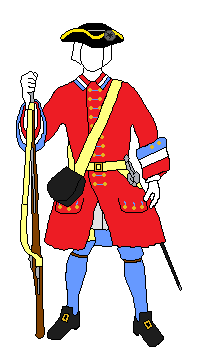
1714-1716 |
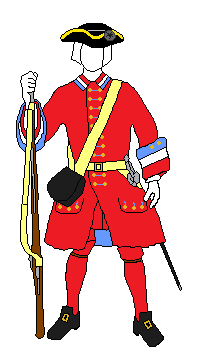
m/1716 |
|
Light grey
coat with brass buttons. Dark red/burgundy cuffs and lining. |
Red coat
with brass buttons and light blue lining. Striped cuffs (red-white-light
blue). |
Same
as before but with red vest and red leg clothes. |
|
West
Sjællandske
National Regiment
("South Sjællandske" from 1717) |

1701-1713 |
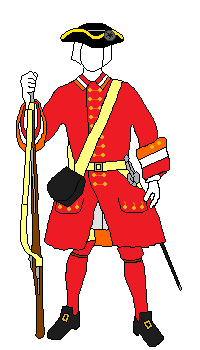
1714-1722 |
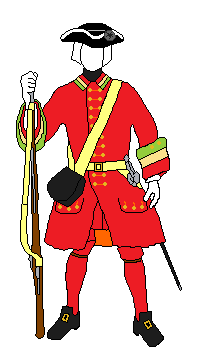
Lolland batttalion
1722-1730 |

Zealand battalion
1722-1730 |
|
Light grey
coat with brass buttons. Aurora coloured cuffs and lining. The piecoat
had blue cuffs in 1701. |
Red coat with
brass buttons and aurora coloured lining. The cuffs were striped in
aurora-white-red. |
Red coat with
brass buttons and aurora coloured lining. The scuffs were striped in
green-paille-red, as well as red vest and leg clothes. |
Red coat
with brass buttons and paille lining. The cuffs were striped in
green-paille-red. Red vest and leg clothes. |
The regiment was issued new uniforms in 1722 and
was supposed to have paille-coloured lining. But there was a large
quantity of aurora coloured baize available and in order not to waste
it, the two battalions were given different lining colours. The Zealand
battalion got paille as the lining colour and the Lolland battalion got
aurora as the lining colour. But in addition to the deviant lining
colour, the Lolland battalion also received yellow hat lace and black neckcloths. The regimental commander complained about the lack of
uniformity and the king authorised the expense of replacing the yellow
hat lace with white lace, but the lining and neckcloths were left as
they were.
Also note that the Lolland soldiers were added to
the regiment during a reorganisation in 1717 and that these may have
kept their uniforms from the former Viborg-Lolland regiment. |
|
Fynske
National Regiment |

1701-1713 |
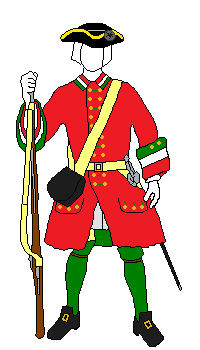
1714-1722 |

m/1716 |
|
Light grey
coat with cinnabar red (vermilion) cuffs and lining, and brass buttons.
In 1702, the hats had red lace and cockades, while the stockings had red
stripes on the sides and on the back |
Red coat
with brass buttons, green lining and striped cuffs (green-red-white).
Green leg clothes since at least 1715. |
Same
as before but with red vest and red leg clothes. |
|
|
Ålborgske
National Regiment |
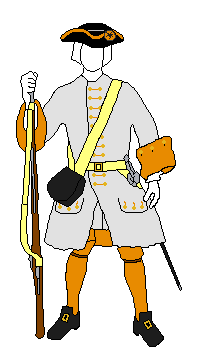
1701-1713 |
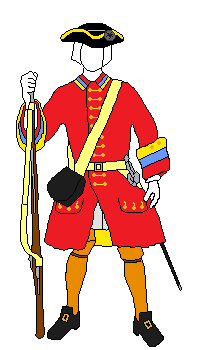
1714-1716 |

m/1716 |

1718-? |
|
Light grey
coat with brass buttons. Cuffs and lining were brown in 1701, feuille
morte in 1708 (also leg clothes) and fire yellow up to and including
1711. |
Red coat with
brass buttons. Yellow lining and striped cuffs in red-blue-yellow. Leg
clothes in feuille morte. |
Same as before
but with red vest and red leg clothes. |
A newly
formed battalion that replaced the one captured by the Swedes in
1716 was given grey vadmal coats, leather breeches and red
stockings. |
|
|
Århusiske
National Regiment |

1701-1713 |

1714-1716 |
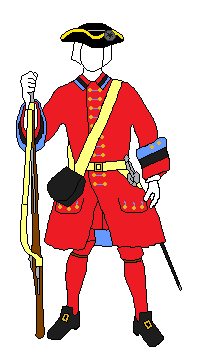
m/1716 |
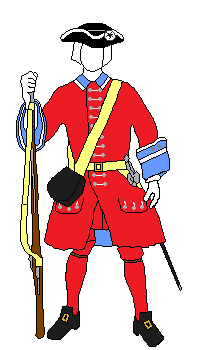
1728 |
|
Light grey
coat with brass buttons, and dark blue cuffs and lining. |
Red coat with
brass buttons, blue lining and striped cuffs (blue-black-red). Blue leg
clothes since at least 1715. |
Same as before
but with red vest and red leg clothes. |
Worgewits depicted the regiment with light blue cuffs and collar
with two and one white stripe respectively. White buttons,
buttonholes, hat lace and cockade. |
|
|
Riberske
National Regiment |

1701-1713 |
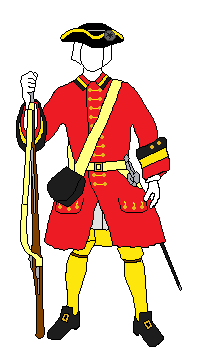
1714-1716 |

m/1716 |
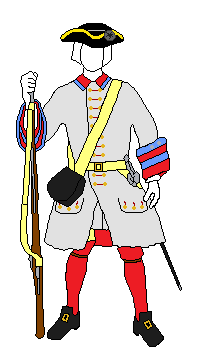
1718-? |
|
Light grey
coat with brass buttons, light green cuffs and lining.. |
Red coat with
brass buttons, yellow lining and striped cuffs (black-yellow-red).
Yellow
leg clothes since at least 1715. |
Red coat with
brass buttons, red lining and red cuffs with two blue stripes and a
collar with a blue stripe. Red vest and leg clothes. |
Two
newly formed companies that replaced those captured by the Swedes
in 1716 were given grey vadmal coats, leather breeches and red
stockings. |
There are different descriptions of what
the m/1716 uniform's cuffs looked like. |
Viborg and
Lolland's
National Regiment
(disbanded 1717) |
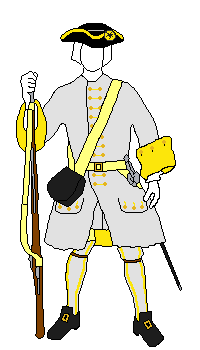
1704-1713 |

1714-1716 |
|
Light grey
coat with brass buttons, yellow cuffs and lining. |
Red coat
with brass buttons and paille lining. Cuffs striped in green-paille-red.
Uniform m/1716 would have had red vest and leg clothes. Unclear if those
were issued before the regiment was disbanded in 1717. |
|
|
Oldenborgske
National Regiment |
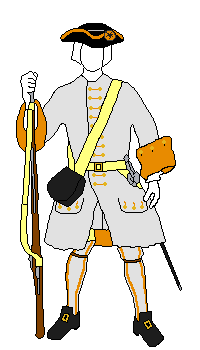
1704-1713 |

1714- |
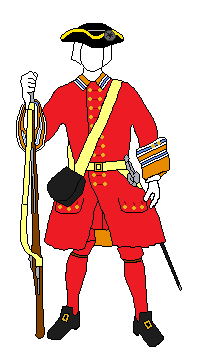
-1731 |
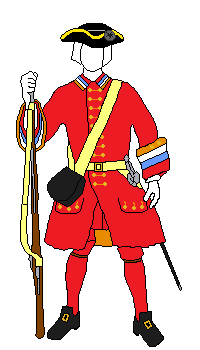
m/1716 |
|
Light grey
coat with brass buttons and feuille morte cuffs and lining. |
Red coat with
yellow buttons and red buttonholes. Lining in feuille morte. Cuffs and
collar in feuille morte with 2x3 stripes in white-light blue-white on
the cuffs and 1x3 on the collar. |
Same as
before, but was to have red vest and leg clothes from 1716 onwards. |
This
uniform does not appear to have been issued, but Oldenburg was,
according to the 1716 regulation, supposed to have four-colour
cuffs in red-blue-white-feuille morte. |
|
|
Garrison Units |
|

Bornholm Militia |

Free companies 1691-1711 |

Free companies 1724 |
|
A resolution from 1703 mentions that the Northern and
Eastern Companies were to wear light grey coats with either green or
orange cuffs. The Southern Company was to wear a dark grey piecoat
with feuille morte cuffs. The Cavalry Company was to have grey piecoats
with red cuffs. |
Light
grey coat with red cuffs. The red colour was at least 1691-1695 dark
red. |
Received
red coats during the Great Northern War but later than the line
infantry. In 1724, feuille morte-coloured baize were delivered to the
free companies. |
|
|
Contemporary images of Danish uniforms
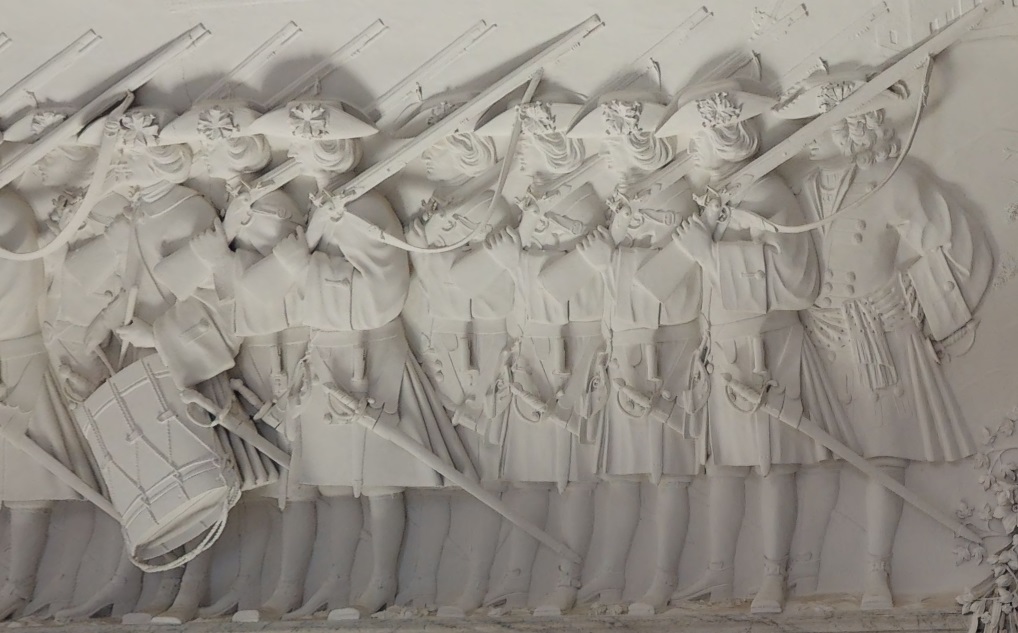
National militia soldiers (conscripts) depicted in 1704-1706 on a relief in Rosenborg castle
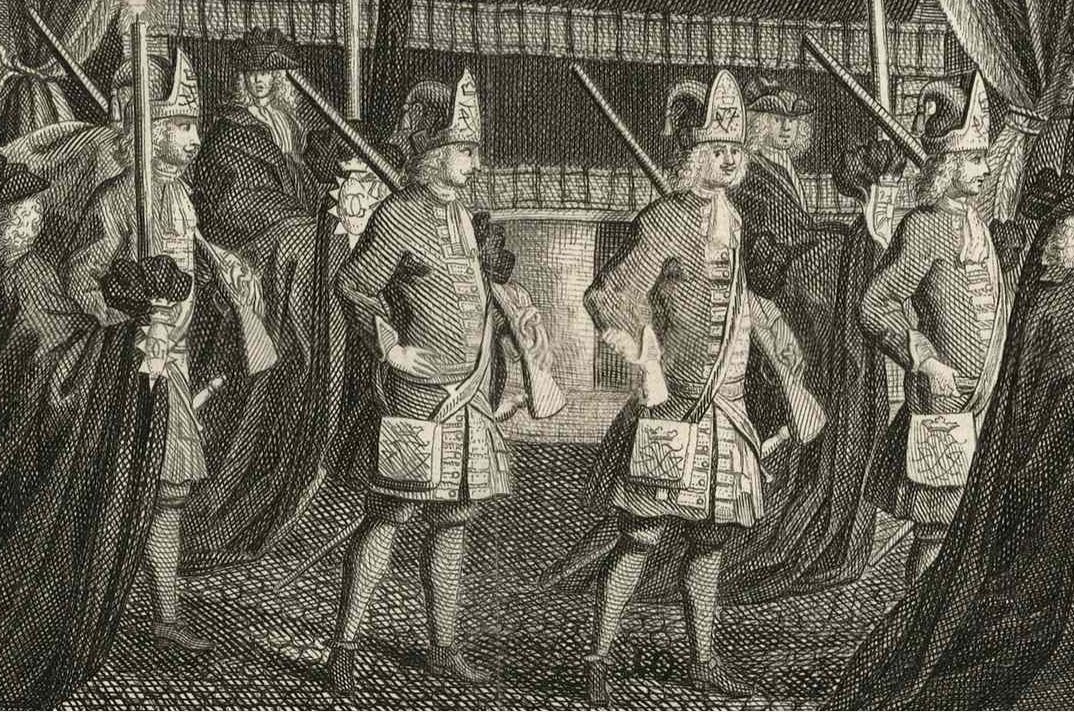
The Grenadier corps at the funeral of Christian Gyldenløve in 1703.
Engraving by Andreas Reinhard ca. 1707.
Read also about Danish cavalry uniforms. |
|
References
Höglund, Lars-Eric – Sallnäs, Åke. Stora nordiska kriget 1700-1721, II.
Karlstad (2003)
Schorr, Daniel. Danish-Norwegian uniforms 1709-1720. *
Skjold Petersen, Karsten. Den danske hærs uniformer
i 1700-tallet. Copenhagen (2005)
Skjold Petersen, Karsten. Kongens klæder. Copenhagen (2014)
Snorrason, Torstein. Danish Uniforms 1699-1712. *
Vaupell, Otto. Den danske hærs historie til nutiden og den norske hærs
historie indtil 1814. Copenhagen (1872-1876)
* = articles published in 2008 on the now defunct website
www.northernwars.com |
|
